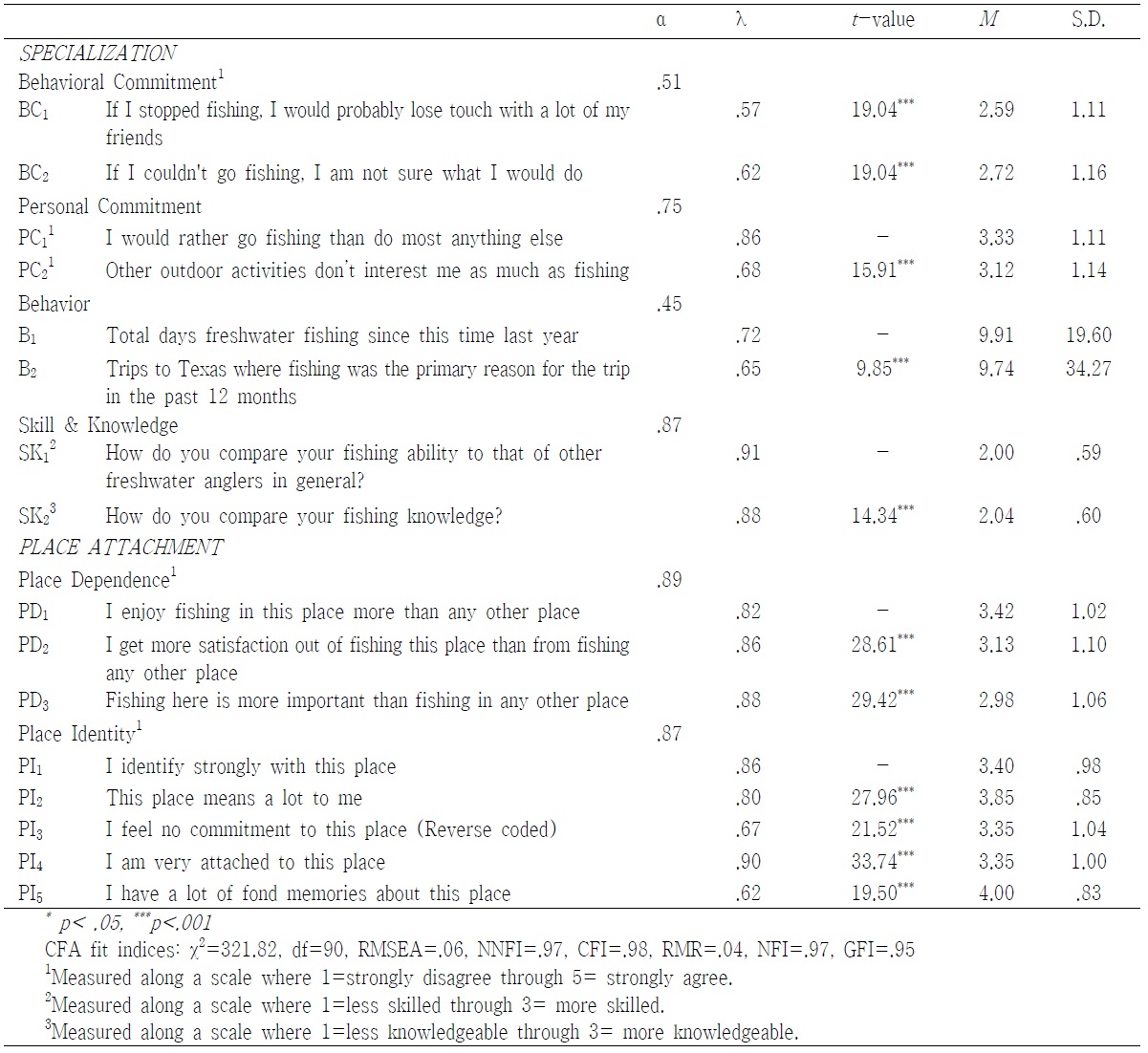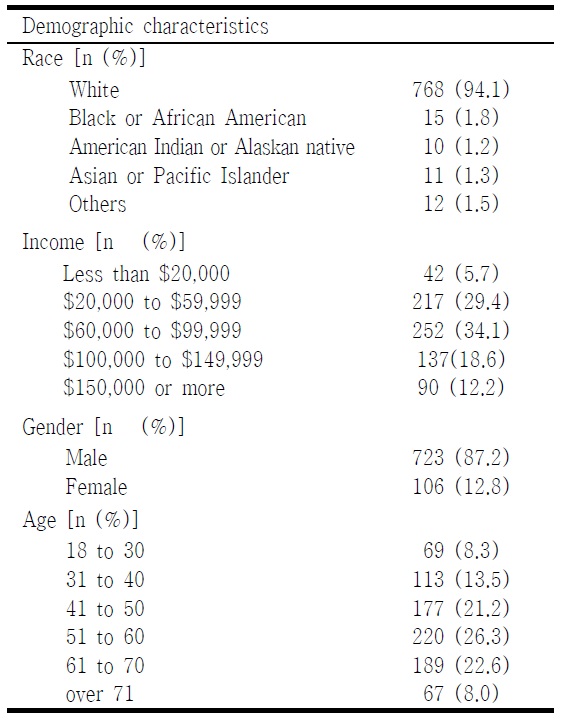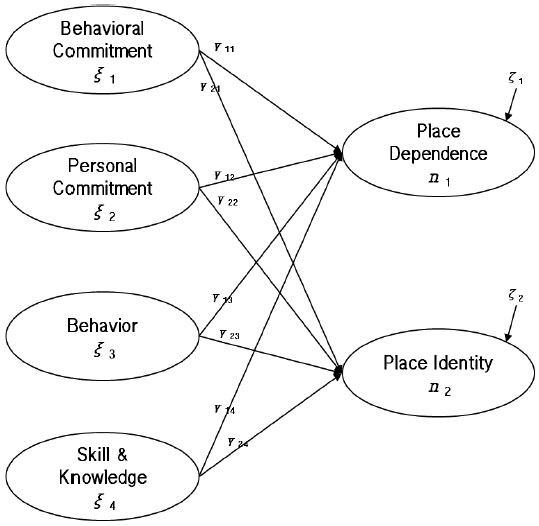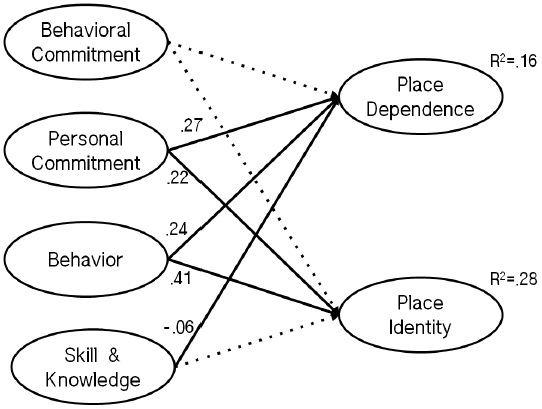


본 연구의 목적은 미국 텍사스를 방문한 여가 낚시객들의 레크리에이션 전문화가 지역애착 형성에 어떠한 영향을 미치는지를 규명하는데 있다. 레크리에이션 전문화와 지역애착을 다룬 기존의 연구와는 달리, 본 연구는 레크리에 이션 전문화가 네 개의 하위요소(행동, 개인적 헌신, 행동적 헌신, 기술 및 지식)로 구성되었다고 보았다. 이 네개의 요소는 지역애착의 두 개의 하위요소에 영향을 미친다고 가정하였다. 연구 결과는 레크리에이션 전문화가 지역애착의 선행요소라는 주장을 뒷받침해주었다. 구체적으로, 개인적 헌신과 행동은 장소의존에 긍정적인 영향을 나타냈으며 기술 및 지식은 부정적 영향을 미치는 것으로 나타났다. 또한 행동과 개인적 헌신은 장소정체성에 긍정적 영향을 미치는 것으로 나타났다. 행동적 헌신은 통계적으로 유의한 결과를 얻지 못했다. 이는 여가 낚시객들이 낚시의 중요성의 인지와 낚시 빈도를 높일수록, 그들의 장소 의존성과 정체성이 높아짐을 나타낸다. 이와 반대 로, 여가 낚시객들의 기술과 지식의 성장은 이들의 장소 의존성을 감소시키는 결과를 보여주었다.
It has long been documented that leisure has played an important role in enriching individuals’ lives and increasing their life satisfaction. The recognized role of leisure in people’s lives has prompted the growth of commercial and not-for-profit organizations which serve to satisfy people’s leisure needs. Since loyal customers account for a high proportion of the profit growth of successful leisure service providers, for both commercial and not-for-profit organizations, it is important to cultivate loyal recreationists to achieve their success. In the context of natural resource-based recreation (e.g., scuba diving, ski, snowboarding, fishing), recreationists’ attachment to specific recreation sites is most often used to refer to the concept of loyalty (Kyle, Graefe, Manning, & Bacon, 2004).
The process by which people develop attachment to places is known as place attachment. In literature on place attachment, many human geographers and environmental psychologists believed that, through interaction with places, people form emotional bonds with and endow values and meanings to the places (Buttimer, 1980; Low & Altman, 1992; Tuan, 1980). Thus, academic attention to places has extended beyond the attributes of places that are appreciated primarily for the commodities or activities they offer. In leisure and recreation literature, attention has been paid to the role of attachment to specific places in explaining recreationists' different attitudes and behaviors such as substitution and displacement of specific leisure places given the offering of alternatives, setting preferences, perceived service quality and satisfaction, acceptability of resource management decision, and activity participation (Kyle, Absher, & Graefe, 2003b; Kyle, Mowen &Tarrant, 2004; Hwang, Lee & Chen, 2005; Shelby & Vaske 1991; Williams, Patterson, Roggenbuck, & Watson, 1992; Yuksel, Yuksel, & Bilim, 2010).
The conceptualization in this investigation draws from the works of Schreyer, Jacob, and White (1981) and Williams and Roggenbuck (1989). Their work suggests that place attachment represents a person’s valuing of a setting and consists of two elements; place identity (emotional-symbolic value) and place dependence (functional value). Place identity refers the extent to which a place affirms individual or group identity. Visiting a favored recreational setting affords the individual or group an opportunity to express themselves. As a place is considered as “special” for emotional and symbolic reasons, it becomes a central aspect of individuals’ lives and self-identification. Place dependence refers to the value that recreationists ascribe to settings because of the settings’ specific attributes that facilitate leisure experiences. As recreationists develop dependence on a place for its utilitarian aspects to fulfill their leisure need, they become less willing to use another site for their particular activities.
Past research has suggested that people’s attachment to recreational settings can be understood in terms of their behavioral, cognitive and affective involvement in leisure activities (Bricker & Kerstetter, 2000; Moore & Graefe, 1994; Oh, Lyu & Hammitt, 2012; Williams, Petterson, Roggenbuck & Watson, 1992). These three aspects of recreationists’ leisure involvement are recognized in the conceptual framework of recreation specialization.
In the leisure literature, the concept of specialization has long been employed for understanding various aspects of outdoor recreationists (e.g., preferences, motivation, attitudes) since its original conceptualization by Bryan (1977, 1979). According to Bryan, as individuals’activity-related experience and commitment to an activity increase, they progress through stages of development in that their attitudes and preferences toward the activity and recreational settings become more sophisticated and specific.
Research on recreation specialization has identified diversity among participants involved in the same activity. In the context of various outdoor activities such as boating, hiking, camping, fishing, hunting, rock climbing, research has illustrated that there were variations among participants in their motivation, preferences for recreation settings and other aspects of involvement (Scott & Shafer, 2001). In addition to identification of diversity, Scott (2012) argued that the recreation specialization framework has made three major contributions to our understanding of leisure phenomena. The framework has enabled scholars to identify and quantify the number of specialized participants, to recognize gradations of seriousness and to apply specialization progress to practice (Scott).
In Korean literature, the construct of recreation specialization has recently received attention (Lee & Lee, 2010). As recreation specialization research in Korea has adopted definition and conceptualization from works published in the U.S. journals (e.g., Journal of Leisure Research, Leisure Sciences, Journal of Park and Recreation Administration), variation between studies published in Korea and the U.S. is not evident in that way (Lee, 2005; Lee & Lee, 2010). However, differences lie in their theoretical approach and research focus. Recreation specialization research in the U.S. has employed cognitive psychology, marketing and sociology perspectives (Lee, 2005; Scott & Shafer, 2001). Especially drawn upon sociology, scholars have focused on the understanding of mechanism underlying progression and illustrated meanings of specialization as a developmental process and ways that progression is likely to manifest itself (e.g., Kuentzel, 1994; Kuentzel & Heberlein, 2006, 2008; Scott & Godbey, 1992, 1994). On the other hand, within psychological or marketing framework, research in Korea has regarded specialization as an indicators of intensity of involvement and focused mainly on relationship of specialization with other variables (e.g., motivation, constraints, satisfaction: Hwang & Lee, 2012; Lee, 2005; Lee & Lee, 2010).
While there has been ongoing discussion on how best to conceptualize the concept, Scott and Shafer (2001) synthesized research on specialization and suggested that behavioral, cognitive and affective facets capture the essence of recreational specialization. The cognitive dimension is evidenced in the level of skills and knowledge while behavioral dimension is reflected in past experience (McFalane, 2004; McIntyre, 1989; Schreyer, Lime & Williams, 1984). Scott and Shafer argued that the affective aspect of specialization consists of two types of commitment: personal and behavioral. Personal commitment refers to the importance of the activity in the form of a rejection of alternative leisure activities. Behavioral commitment represents costs and penalties (e.g., loss of friends or identity). Since recreationists have already invested significant amount of efforts and resources into their leisure activities, they perceive withdrawal as severe penalties.
Bryan’s (1979) initial work suggested recreation specialization as an antecedent of place attachment. As recreationists become more specialized into a recreation activity, they become more dependent on particular settings and obtain sophisticated preference toward physical and social attributes of the settings. From cognitive psychological perspectives, specialization – place attachment relation can be understood in terms of the development of mental organization and information structure (Schreyer & Beaulieu, 1986; Williams 1985; Williams, Schreyer, & Knopf, 1990). As participants’experience in a recreation activity increases, their cognitions become more complex and the amount of information they can use to evaluate participation and recreation sites grows. Increased cognitive ability and information can lead to change in recreationists’ value and preference toward recreation sites. Within various conceptual frameworks including recreation specialization, commitment or involvement, several research has provided evidences supporting the relation between recreation specialization and place attachment (e.g., Bricker & Kerstetter, 2000; Moore & Graefe, 1994; Oh et al., 2012; Williams et al., 1992). For instance, Moore and Graefe (1994) documented that place dependence and place identity were positively predicted by the importance of a leisure activity and behavioral involvement (i.e., frequency of trail use) among rail-trail users. Using a series of Analysis of variance (ANOVAs), Bricker and Kerstetter (2000) found that as whitewater recreationists’ level of skill increased, their scores on the dimension of place identity increased but the scores on the place dependence decreased. Recently, Oh and his colleagues (2012) showed that recreational anglers’ place identity was positively predicted by their skill and knowledge and commitment while place dependence was positively predicted by commitment alone.
While past research made considerable contribution to our understanding of the recreation specialization – place attachment relationship, they were somewhat limited in several ways. First, one or both of key constructs (recreation specialization and place attachment) was treated as a unidimensional instead of multi-dimensional (e.g., Moore & Graefe, 1994; Williams et al., 1992). Second, the findings from bivariate analyses were unable to show how specialization plays a role in the development of place attachment (e.g., Bricker & Kerstetter, 2000; Williams et al., 1992). Given the field’s current understanding of the constructs (tripartite and bipartite approaches for specialization and place attachment, respectively), relationships between the constructs should be tested in a “simultaneous analysis of the entire system of variables to determine the extent to which it is consistent with the data”(Byrne, 1998) - i.e., structural equation modeling. While Oh and his colleagues’ study conceptualized two constructs as multidimensional and was able to provide empirical evidences showing that specialization preceded place attachment, affective aspect of specialization was treated as a single dimension, failing to distinguish between personal commitment and behavioral commitment.
Acknowledging limitations of past work, the purpose of this study is to provide empirical evidences on recreation – place attachment relationship. By conceptualizing recreation specialization as a four sub-dimensional construct, this study aims to provide a more precise picture of the relationship between recreation specialization and place attachment at the dimensional level. As shown in <Figure 1>, it was hypothesized that the four dimensions of specialization (behavior, skill & knowledge, personal commitment and behavioral commitment) predict the two dimensions of place attachment (place identity and place dependence).
The hypothesized model was tested with a sample drawn from recreational anglers who visited Texas, the United States. The importance of recreational anglers in North American leisure literature lies in two ways. First, recreational fishing has long been one of the most frequently engaged recreational outdoor activities in the U.S. (Outdoor Recreation Participation Report, 2010). Second, due to its popularity among North Americans and the fact that fishing heavily depends on natural resources, anglers have traditionally been of research interest in recreation specialization literature where many of researchers are predisposed to conducting applied research on behalf of natural resource agencies (e.g., Chipman & Helfrich, 1988; Ditton, Loomis, & Choi, 1992; Fisher, 1997; Oh et al., 2012; Salz, Loomis, & Finn, 2001)
This study employed Scott and Shafer’s conceptualization of recreation specialization in which the construct consists of four dimensions: behavior, skill & knowledge, behavioral commitment and personal commitment <Table 1>. Behavior was measured by asking respondents “number of days participating in fishing in the previous 12 months” and “number of trips to Texas where fishing was the primary reason for the trip in the past 12 months.” Skill & knowledge was measured by asking respondents to rate their fishing skill and knowledge compared to other anglers on a 3-point scale where 1= less skilled/knowledgeable through 3= more skilled/knowledgeable. Behavioral commitment was measured using two items on a 5-point Likert type scale where 1= strongly disagree through 5= strongly agree. Personal commitment was measured using two items on a 5-point Likert type scale where 1= strongly disagree through 5= strongly agree. Place attachment was conceptualized in terms of two dimensions: place dependence and place identity. Place dependence was measured using five items and place identity was measured with three items on a 5-point Likert type scale where 1= strongly disagree through 5= strongly agree <Table 1>.
[Table 1] Confirmatory factor analysis, reliability, and item descriptives

Confirmatory factor analysis, reliability, and item descriptives
A random stratified sample procedure was conducted to sample non-resident anglers licensed to fish in Texas in United States during the license year 2006-2007. Specifically, non-resident anglers were stratified into two: those in four states lying adjacent to Texas (i.e., Arkansas, Louisiana, New Mexico, and Oklahoma) and those in non-adjacent states. For the adjacent states (Arkansas, Louisiana, New Mexico, and Oklahoma), 583 license holders from each state were randomly sampled while for non-adjacent states, 1,651 names and addresses of non-resident anglers were randomly selected. This allowed survey estimates to be representative of the total population of non-resident license holders with a +5% margin of error. Overall, 3,983 non-resident license holders were selected to participate in the study. Completed surveys were received from 1,611 of the 3,983 license holders (40% of response rate). Questions examining their attachment to their favorite fishing location were asked for freshwater anglers only (n= 817).
The test of a hypothesized model began with an examination of the measurement model (i.e., confirmatory factor analysis: CFA) followed by the structural model (i.e., structural equation modeling: SEM). These analyses were conducted using covariance structure analysis provided through LISREL (version 8.50).
The socio-demographic profile of respondents is reported in <Table 2>. Most respondents were White (94.1%). The median income fell in the range of $60,000 and $99,999. Approximately 90 percent of the respondents (87.2%) was male. The majority of respondents (70.1%) aged between 41 and 70.
[Table 2] Socio-demographic characteristics of respondents

Socio-demographic characteristics of respondents
Results of the CFA indicated satisfactory model fit (χ2 =321.82,
The purpose of this study was to explore how individuals’ progression in recreation specialization influences their attachment to specific recreation settings. Recognizing the limitations of previous work on the relationship between recreation specialization and place attachment (i.e., conceptualization of key constructs and analyses of the relation), this study tested the model in which four dimensions of recreation specialization predict two dimensions of place attachment. A sample drawn from freshwater anglers who visited Texas was used to test hypothesized relations. Findings of the study supported the contention that recreation specialization is an antecedent of place attachment. The relations among each of the dimensions, however, were not uniform. Specifically, following relationships were observed:
First, results of this investigation showed that three different dimensions of specialization – personal commitment, behavior, skill & knowledge – significantly influenced place dependence. Personal commitment and behavior were positively associated with place dependence while skill and knowledge was negatively related to place dependence. As described above, place dependence is formed when the specificity and functionality of a specific place is able to fulfill individuals’ desire (Stokols & Shumaker, 1981). The findings of this study indicated that as recreational anglers perceived fishing more important and fished more frequently in Texas, they tended to rely on the functional capability of Texas and place more value on its unique qualities as a fishing destination. On the other hand, as a level of skill and knowledge increased, a level of place dependence declined. That is, as recreational anglers invested more resources in skill and knowledge, they were less likely to develop functional attachment to their fishing environment. The negative relationship between skill & knowledge and place dependence might indicate that Texas was not able to provide enough challenges that match respondents’ skill and knowledge level. Results of this study also showed that respondents’ personal commitment was more strongly related to place dependence (β=.27) than behavior (β=.24) and skill & knowledge (β=-.06). The finding was consistent with literature suggesting that the commitment to leisure activities is the most robust predictor of place attachment (Gross & Brown, 2008; Kyle et al., 2004; Moore & Graefe, 1994).
Second, place identity was significantly predicted by two dimensions of specialization – personal commitment and behavior. Recreational anglers who made more affective and conative commitment to fish tended to identify themselves with fishing settings. For place identity, behavior (
Third, results of this study showed that behavioral commitment had no significant impact on place attachment. Following Scott and Shafer’s (2001) conceptualization, this study considered that affective aspect of recreation specialization consists of two elements – personal commitment and behavioral commitment. As described earlier, personal commitment measured the importance of a leisure activity while behavior commitment measured the consequences and costs of discontinuing leisure participation. In so doing, this study was able to provide a more comprehensive understanding of formative process of place attachment. The results revealed that personal commitment and behavioral commitment worked on place attachment differently. While the increased importance of and positive emotions derived from fishing led the bond between anglers and fishing places, the external and obligatory commitment counted little on their attachment to the places.
Non-significant paths between recreation specialization and place attachment warrant further discussion. Our results indicated that behavioral commitment had no statistically significant effect on place dependence. As discussed earlier, place dependence refers the utilitarian aspect (i.e., functional capability) of a recreation setting to satiate a recreationist’s desire. The findings of our study indicated that externally committed anglers were unable to appreciate the specificity and functionality Texas can offer its visitors. Also, the results showed that there was no significant relationship between behavioral commitment, skill & knowledge and place identity. It is possible that developing fishing skills and knowledge and increasing fear of identity loss help to maintain and strengthen a sense of who they are as an angler. However, identification with a place comes from repetitive verification of person’s identity through interactions with others within the place and positive emotions occurred at the place, which was reflected in the significant relationships between personal commitment, behavior and place identity in this study. Thus, the specialization process in terms of skill & knowledge and behavioral commitment did not play a significant role in recreationists’ identification process with their recreation setting. Alternatively, it is possible that personal commitment and behavior might have overridden effects of behavioral commitment and skill & knowledge on place identity.
As a guide for future research, conceptualizing recreation specialization as four-dimensional construct could provide researchers with more comprehensive picture in understanding the dimensional relationship. Combined with that previous work, the findings of this study suggest the importance of examining the recreation specialization-place attachment relationship at the dimensional level. Treating the constructs as unidimensional or failing to identify all dimensions provide only a superficial understanding of the nature of the relationship. As the conceptualization employed in this study provided insight on how the variety of meanings individuals endowed upon leisure activities influences the meanings they associated with the leisure settings, it is recommended for future research to adopt four-dimensional conceptualization of recreation specialization.
The findings that recreation specialization precedes individuals’functional and emotional attachment to a specific recreation setting suggests important management and planning application: to tailor management and planning efforts on the basis of agency’s objective. For instance, if an agency aims to develop loyalty among its customers or constituents, the ways to improve its customers’recreation specialization progress should be incorporated and accounted for in their planning and management process. For the agency with goal of increasing utilitarian value of its natural resources, it should focus on the improvement of place dependency among customers by enhancing their leisure experiences through appropriate modifications to the setting such as facility provision or development, trail maintenance or impact management.
Given the reported variability of recreation specialization and place attachment by activity type and geographical location, considerable work will need to be undertaken before generalizable relationship emerge. Also, the inclusion of other variables (e.g., attitudes, motivation, perceived constraints, personality, values) will undoubtedly provide further strengthening the model tested and insight on underlying mechanism of the relationship between recreation specialization and place attachment.



